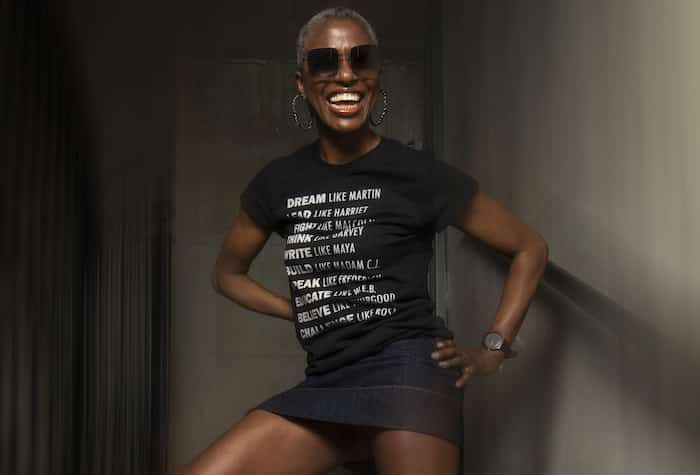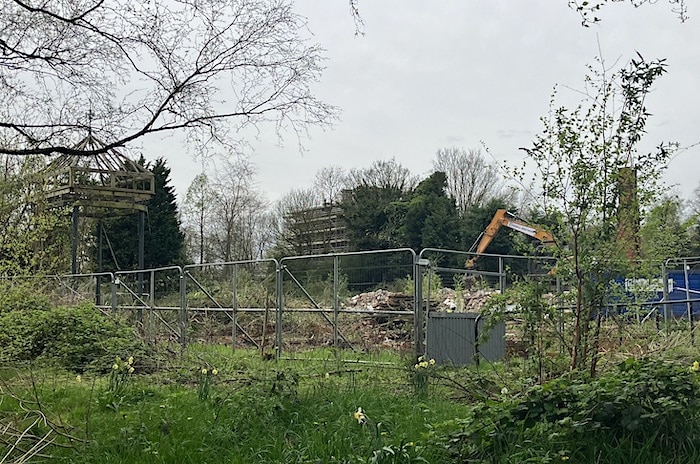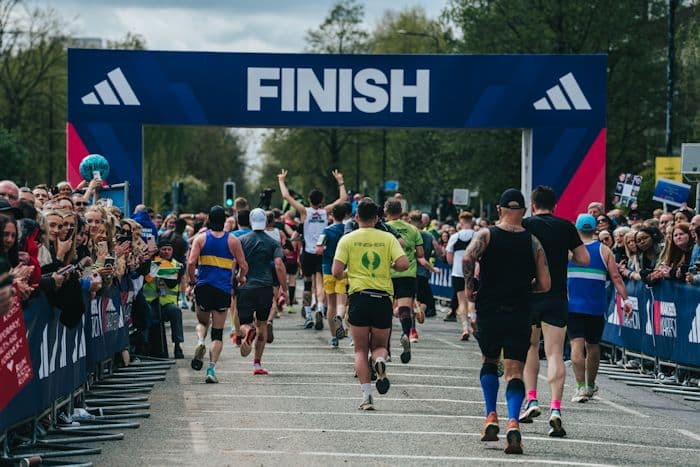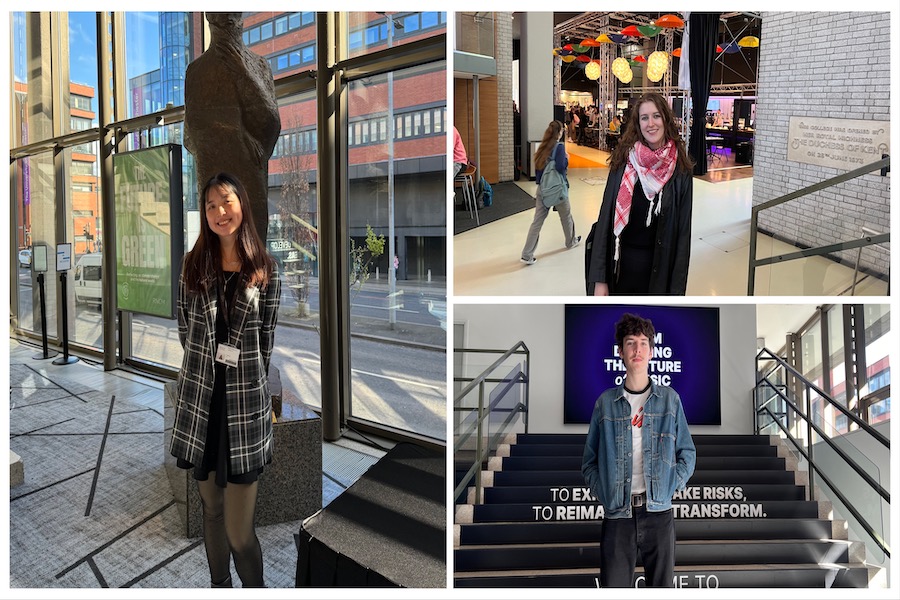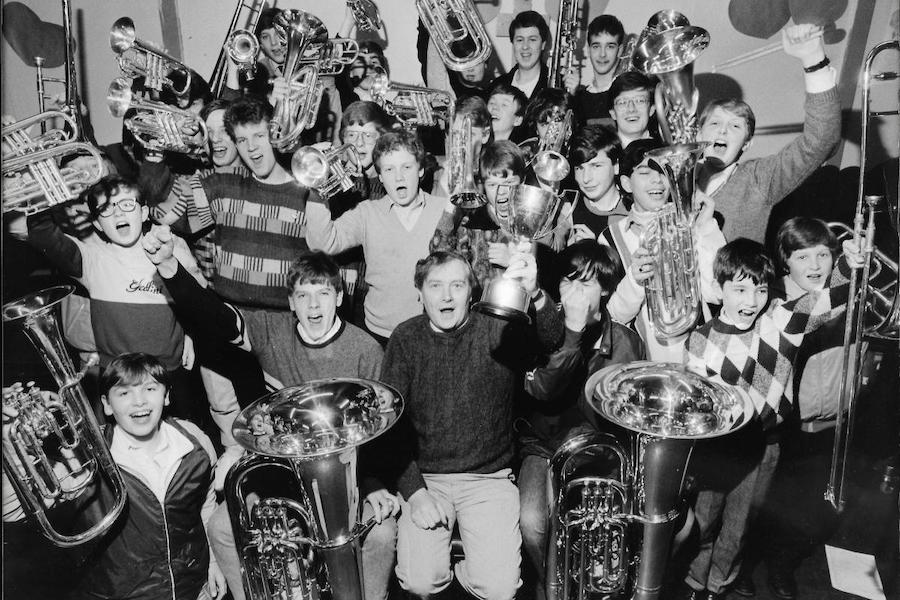Greater Manchester’s most notable statues and sculptures – what they stand for and where to find them
- Written by Stephen Lewis
- Last updated 3 months ago
- Art & Design, Cornerstone, History
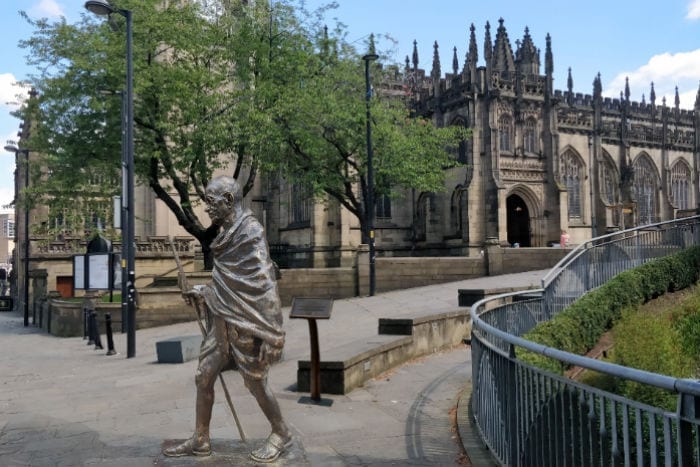
From Manchester’s Piccadilly Gardens to the streets of Stockport, each iconic sculpture captures the history, culture and brave and brilliant people at the heart of towns across Greater Manchester. Cultural education charity Art UK have also given us a hand on the hunt for the iconic monuments and lesser-known gems sitting in local gardens, streets and squares across the city region.
Abraham Lincoln statue
It may seem unusual for Manchester to have a statue of Abraham Lincoln, as there are no obvious links to the 16th president of the United States. But in fact, Manchester was a very important ally to Abraham Lincoln’s Union during the American Civil War. The statue sculpted by George Grey Bernard after the First World War is a reminder of the historic link between the US Civil War and Victorian Manchester. Its location is not really befitting for one of the most iconic figures in American history; the square is terminally quiet and surrounded by dull office blocks.
Brazennose Street, Manchester
Robert Owen statue
The statue of Robert Owen, one of the fathers of the co-operative movement, stands appropriately outside the Cooperative Bank Headquarters on Corporation Street. Manchester’s statue of Robert Owen is a copy of one erected in Owen’s birthplace, Newtown in 1956. This was designed by Gilbert Bayes and completed by W. E. King.
Balloon Street, Manchester
Queen Victoria statue
An over-life-size bronze statue of Queen Victoria seated on a large throne. She is wearing a lace dress with the Order of Garter. Under the coronet is a veil. A sceptre is held in the right hand, an orb in the left. Above the Queen’s head is the royal coat of arms. In the space between the mouldings at the top of the throne is a bronze figure of St George fighting the dragon. On the rear of the surround, positioned in a recess and decorated in blue mosaic tiles, is a bronze sculpture of a female figure, representing Motherhood.
Piccadilly, Manchester
‘Our Emmeline’ Pankhurst statue
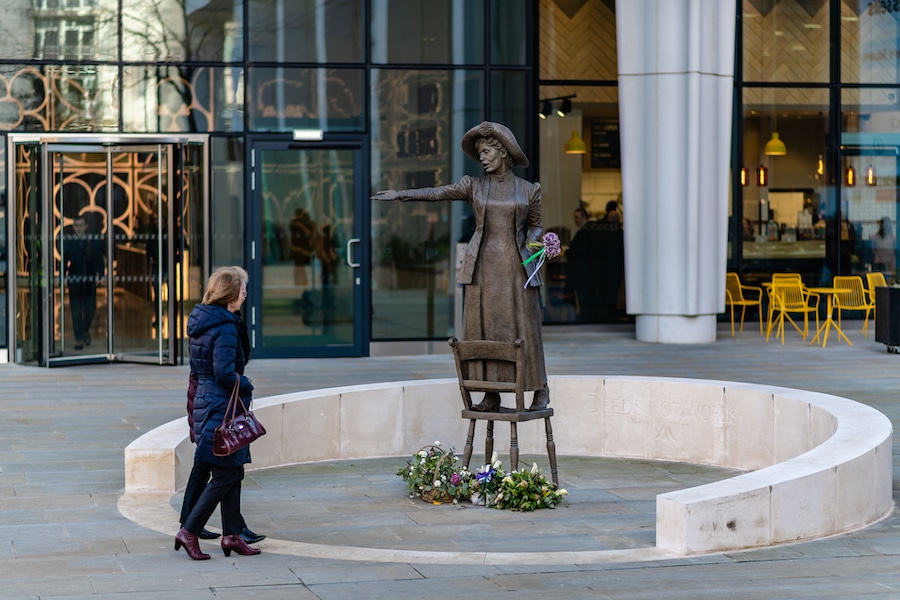
A hundred years after the first women in the UK voted in a general election, a statue of Emmeline Pankhurst by award-winning figurative sculptor Hazel Reeves was unveiled in St Peter’s Square. Our Emmeline is the first statue of a woman in Manchester since that of Queen Victoria was unveiled in Piccadilly Gardens in 1901.
St Peter’s Square, Manchester
Victory over Blindness statue
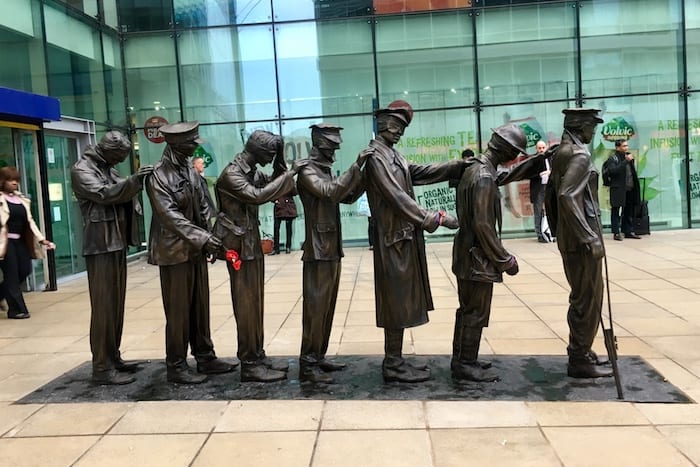
The Victory over Blindness statue in front of Piccadilly Station depicts seven First World War ex-servicemen supporting each other and commemorates the returning veterans who lost their sight in the Great War. They are now set upon the path to rebuilding their lives after the conflict.
Piccadilly Station, Manchester
Duke of Wellington statue (1769–1852)
An over-life-size bronze statue of Wellington surmounting large grey granite stepped pedestal at the corners of which are four seated symbolic figures. Wellington, dressed in a military frock coat with military decoration, is depicted speaking in the House of Lords. A pile of Wellington’s published military despatches is placed behind his right foot. At the front of the pedestal are the figure of Minerva, representing wisdom, and the helmeted figure of Mars, sword in hand, exemplifying valour.
Piccadilly, Manchester
South African War Memorial
Hamo Thornycroft’s The Last Shot stood recognises those who lost their lives during the Boer War in South Africa between 1899 and 1902.
St Ann’s Square, Manchester
Mahatma Gandhi statue
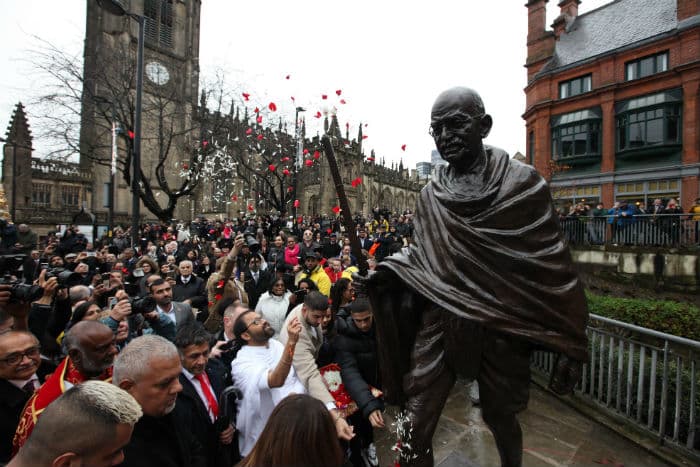
A 9ft high bronze statue by renowned Indian artist Ram V Sutar was erected to mark the 150th anniversary of Gandhi’s birth. Shrimad Rajchandra Mission Dharampur (SRMD), a worldwide spiritual movement headquartered in India, is behind the initiative, which is supported by Manchester Cathedral, Manchester City Council, Manchester India Partnership and the High Commission of India. Gandhi visited Manchester in 1931.
Manchester Cathedral
The Chopin Memorial Monument
Frederic Chopin was a Polish composer and pianist who was recognised worldwide as a leading musician of his era. His monument is a symbol of friendship between Poland and the UK. Designed by Polish sculptor Robert Sobocinski, it depicts the musician seated at his piano gazing across to his muse Baroness Aurore Lucile Dupon. If you look closely you will see an eagle – the symbol of Poland – carved into the wood.
Deansgate, Manchester
John Bright statue
John Bright was a Radical and Liberal statesman who was born in Rochdale in 1811. He sat in the House of Commons from 1843 to 1889 where he promoted free trade, electoral reform, and religious freedom.
Albert Square, Manchester
L. S. Lowry sculpture
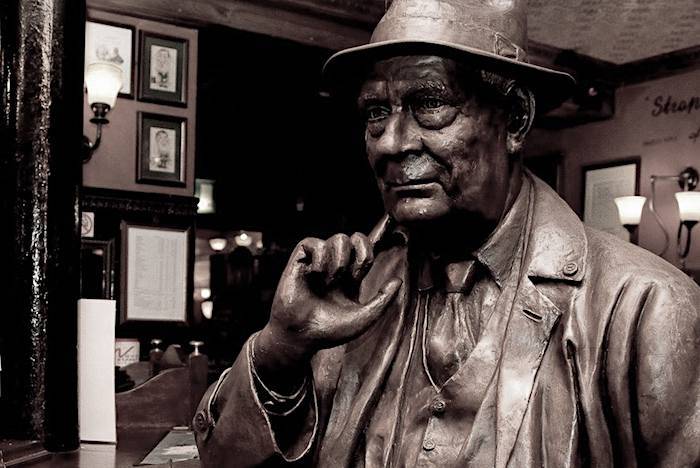
L. S. Lowry was a regular at Sam’s Chop House pub. Many of the waitresses from that era can still remember him now and how he used to have one glass of sherry or a half of Wilson’s Bitter (he wasn’t much of a drinker) while he doodled on napkins. He often gave these drawings away as tips. Inspired by the statue of Ernest Hemingway at El Floridita in Cuba, Sam’s Chop House owner Roger Ward approached and commissioned Preston-based sculptor Peter Hodgkinson to create a bronze sculpture of Mr Lowry to be fixed to the bar. One finger rests on his chin as he seems to ponder the selection of whisky and brandy on the back bar.
Sam’s Chop House Manchester
Adrift statue

This bronze sculpture was created by John Cassidy in 1908, and first stood in the New Gallery London before being bought by a wealthy engineer who donated it to the city council. It depicts a family clinging to a raft in a stormy sea. The original plaque carried the words: “Humanity adrift on the sea of life, depicting sorrows and dangers, hopes and fears and embodying the dependence of human beings upon one another, the response of human sympathy to human needs, and the inevitable dependence upon divine aid.”
St Peter’s Square, Manchester
Life Cycle statue
George Wylie’s Life Cycle is a giant silver bike. Commissioned to coincide with an environmental conference hosted in Manchester in 1995, this statue originally stood in Albert Square before being moved to its current location. A quirky addition to the city.
Deansgate Station, Manchester
Friedrich Engels statue
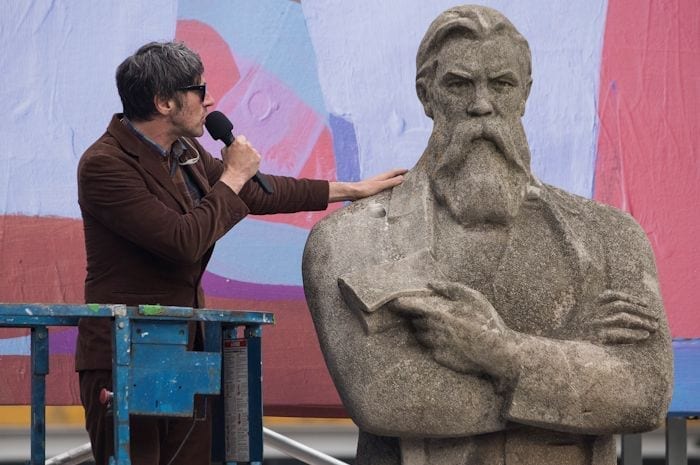
Engels spent over two decades in the city after he was sent here to work in a textile mill his father owned, in the hope it would de-radicalise him. This plan failed spectacularly. During his time here, he took a keen interest in the conditions of the working class and met Karl Marx. Together they wrote The Communist Manifesto. The statue was moved from a tiny Ukrainian village to First Street by artist Phil Collins as part of last year’s Manchester International Festival.
First Street, Manchester
Alan Turing statue
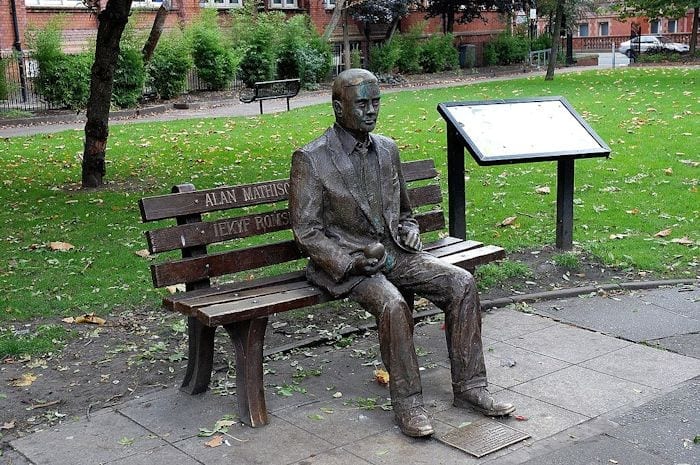
Best known for helping crack the Enigma code during the Second World War, Alan Turing is considered the father of computer science. After the war he designed the ACE – among the first designs for a computer – and while in Manchester worked on one of the world’s first computers: the Manchester Mark I. Turing was prosecuted for ‘homosexual acts’ in 1952 for which he accepted chemical castration treatment as an alternative to prison. He took his own life in 1954 and was formally pardoned by the Queen in 2013.
Sackville Gardens, Manchester
Vimto statue
A giant statue dedicated to Manchester’s greatest non-alcoholic beverage. It was carved by Kerry Morrison and installed in 1992 on the site of the factory in which the first batch of Vimto was made by John Noel Nichols in 1908. It underwent a makeover after 19 years of Manchester weather took its toll. The grapes and raspberries were restored, with the grapes changing from red to green to properly reflect the ingredients of Vimto, with the blackcurrants being replaced too.
Sackville Street, Manchester
Homeless Jesus statue
A newly installed statue of Jesus the Homeless by Canadian artist Timothy Schmalz depicts a figure lying on a bench. Its pierced feet indicate it is Jesus, and the near life-size bronze statue has been blessed by the Bishop of Manchester. The aim of the homeless Jesus artwork is to challenge passers-by to question their attitude towards the homeless and marginalised, and the statue follows similar pieces in Glasgow, Rome and the US.
St Ann’s Church, Manchester
James Watt statue
Watt is shown seated holding a pair of dividers, and a scroll of paper on his lap. It surmounts a stone pedestal. James Watt was an engineer and inventor. In the 1760s he began investigating ways to improve existing steam engines. His improvements, including the separate condenser, were commercially exploited in his partnership with Matthew Boulton. Beginning in 1774 at the famous Soho works, Birmingham, Boulton and Watt began to manufacture the engines that made the use of steam power a practical reality for many industries.
Piccadilly, Manchester
Tree of Remembrance statue
A memorial to the civilians of Manchester who were killed between 1940 and 1945 during the Second World War. The sculpture was erected on the anniversary of VE Day. There are metal rings around the trunk that hold the names of the Manchester civilians who lost their lives during the conflict. Many of those lost died in the bombings of 22 and 23 December 1940. Over the two nights around 500 German bombers dropped 467 tons of high explosive and 2000 incendiary bombs on the city.
Mosley Street, Manchester
War Memorial statue
An ornamental fountain. The plinth with inscription, bronze portrait roundel, fountain niche and bowl on faces, supports clustered columns in pink granite, carved capitals, below a block with a clock face, gable top and foliated finial. Sir William Houldsworth Bart. (1834–1917), cotton manufacturer, was born in Manchester as the fourth son of cotton spinner Henry Houldsworth. He was educated at the University of St Andrews and joined the family firm as a partner.
Heaton Moor Road, Stockport
Tameside’s World Cup Heroes statue
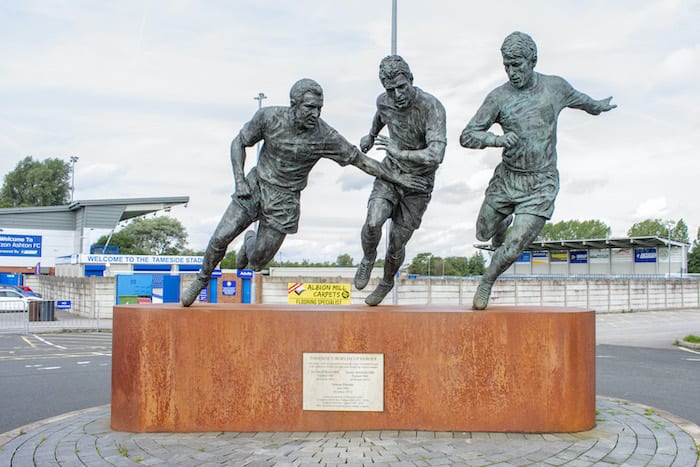
A statue of three World Cup winners born in Tameside: Sir Geoff Hurst, who bagged a hat-trick in the 1966 World Cup win over West Germany at Wembley, was born in Ashton in 1941 and spent his early years living in neighbouring Denton before his family moved to Essex; Jimmy Armfield OBE, a former Blackpool star who was a member of the England squad for the finals, was also born and raised in Denton; and Simone Perrotta, a member of Italy’s 2006 World Cup-winning team, who was born in Ashton to an Italian family in 1977.
Richmond Street, Ashton-under-Lyne
Pull the Plug, Ring the Change statue
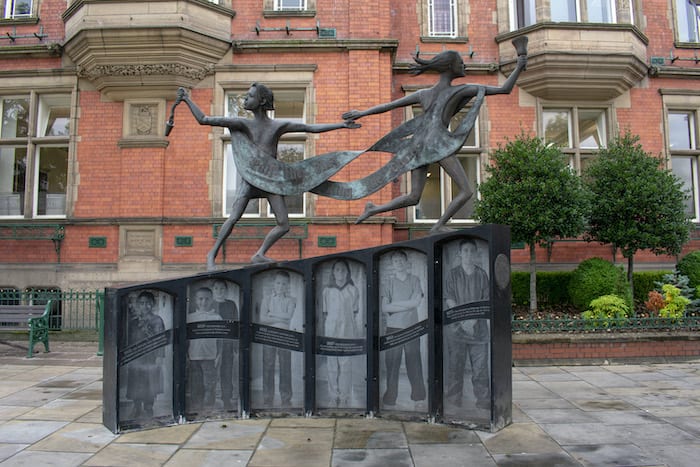
A chartist statue recognising the important part the people of Hyde played in the reform of parliament, and their struggle to improve the working conditions of men, women and children. The sculpture consists of the elevated figures of two children running triumphantly, one holding aloft a plug, the other ringing a bell. A torn banner inscribed with the slogan ‘Pulling the Plug, Ringing the Change’ is draped between the figures creating a sense of movement.
Market Street, Hyde
L. S. Lowry statue (1887–1976)
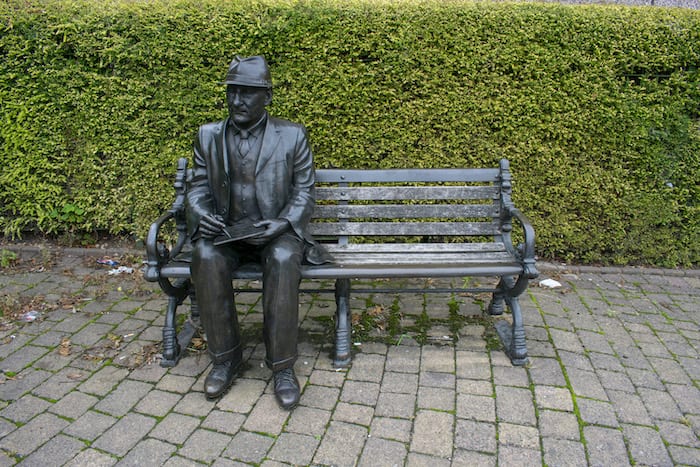
A life-sized statue of L. S. Lowry seated on a bench, sketching. The Stretford-born artist lived in Mottram from 1948 until his death in 1976. In Mottram in Longdendale sits a charming, life-sized sculpture of renowned Stretford-born artist, L. S. Lowry. Lowry lived in the village from 1948 until his death in 1976 and Cox’s sculpture captures him seated on a bench, quietly sketching. The artist is a national favourite, known for his sombre yet charismatic paintings of architecture and industrial landscapes.
Stalybridge Road, Mottram in Longdendale
The Ashton Munitions Explosion Memorial
A permanent memorial to the victims of the munitions explosion that occurred on 13 June 1917 at the Hooley Hill Rubber and Chemical Company, Ashton-under-Lyne. Forty-six people were killed, including children making their way home from school. More than 400 people were injured and around 2,000 were made homeless because of the widespread damage to properties as far away as Dukinfield and Hurst. The blast left two large craters, one of which was 90 feet wide and five feet deep.
Stamford Street West, Ashton-under-Lyne
Coal Miner statue
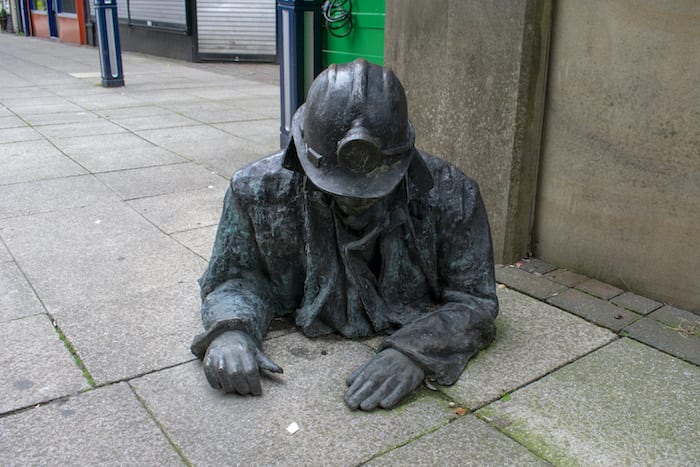
A bronze figure of a coal miner emerges from the ground on a street in Ashton-under-Lyne – a nod to the importance of coal mining in the town’s history.
Market Street, Ashton-under-Lyne
The Ashton Town Centre Sculpture
This sculpture is sited at the boundaries of the medieval old town and contains castings from the town’s industries and folklore, including a spoon signifying the birthplace of Arthur Brookes, founder of the tea brand Brooke Bond. The metal grid in the centre of the sculpture is in the shape of a map of the grid pattern of Ashton’s streets. The work was commissioned by Ashton Renewal Area and Tameside’s arts and regeneration project and was funded by European grants.
George Street, Ashton-under-Lyne
Jack Judge statue (1872–1938)
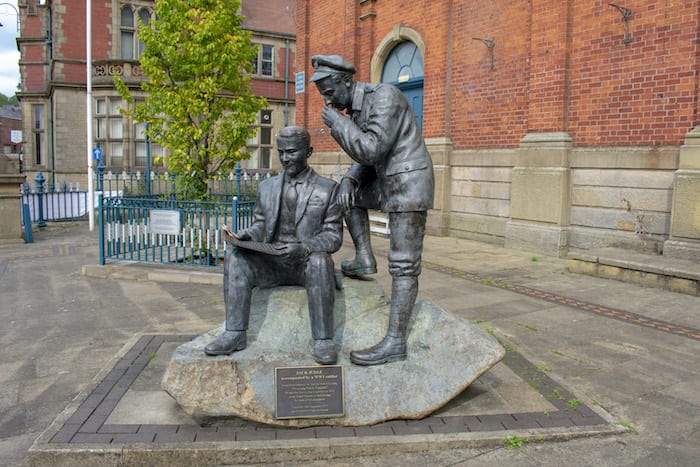
The statue is a permanent tribute to Jack Judge, whose wartime song It’s a Long Way to Tipperary made him world famous and who lived in Stalybridge. It portrays him sitting on a granite rock holding his music score with a First World War soldier leaning over his shoulder. His first performance of the song was at Old Grand Theatre in Stalybridge. Frank Judge, whose great grandfather was Jack’s brother, played the song on the bagpipes at the unveiling ceremony along with the Stalybridge Brass Band.
Trinity Street, Stalybridge
Colonel Robert Duckenfield statue (1619–1689)
A black metal column supports a polished metal flaming sword encircling the helmet of a Roundhead soldier. Set into the concrete around the base of the column are representations of artefacts associated with the Civil War including a cavalry boot. It surmounts a small tapered base made of stone bricks. The sculpture stands in the centre of the main walkway, close to the entrance of Dukinfield Park, on a site previously occupied by an Edwardian fountain.
King Street, Dukinfield
James Conway Memorial
James Conway, a Royal Marine, was one of 12 men chosen to paddle over 80 miles in canoes to plant mines on vessels in the German-occupied French port of Bordeaux in 1942. Only two men survived the raid. Conway, from Stockport, Greater Manchester, was captured and killed. The operation’s significance reportedly led Prime Minister Winston Churchill to say he believed the mission could have shortened the war by six months.
Wellington Road South, Stockport
Moravian Woman and Child statue
The Unitas Fratrum (Moravian Church) was founded in what is now the Czech Republic by followers of the reformer, John Huss. It claims to be the oldest protestant movement in Europe and was a pioneer of protestant missions. Fairfield was the last of the Moravian settlements in England established in the eighteenth century, the original being Fulneck near Bradford in Yorkshire. The Moravians settled at Fairfield when the Church, Sisters’ House and Brethren’s’ House were formally opened in 1783, the settlement having been planned and built by members of the Moravian congregation who had been previously located in Dukinfield.
Fairfield Road, Droylsden
Oliver Cromwell

The hugely divisive figure of Oliver Cromwell looms large across Wythenshawe Park in Manchester.
Love him or hate him, there’s no denying the huge role he’s played in English history – for good or evil.
The Grade II listed bronze statue of Cromwell, which is mounted on a granite plinth and pedestal, is dated 1875.
It was originally located on Deansgate.
Wythenshawe Park, Wythenshawe
Tipping the Denton Linney statue
A life-sized statue of a suave man in bronze doffing his Linney hat which, along with the Attaboy, was a famous make once manufactured in Denton. Linney was a founder of the manufacturing company Walker, Ashworth & Linney Ltd. A gentle tribute to workers of the town’s once-booming hat industry, the statue stands outside the former Denton Town Hall (now a library).
Market Street, Denton
War Memorial statue
This memorial comprises a bronze statue of a soldier in battle dress, both hands holding the rifle, standing on a square, light-grey granite pedestal with a cornice. Dark marble panels on the pedestal are inscribed with the names of over 140 servicemen who died in the First World War. The principal inscriptions are placed at the base of the pedestal on all four sides. Stone tablets placed around the base record the names of the dead of the Second World War.
Cemetery Road, Audenshaw
Blue Peter Ship sculpture
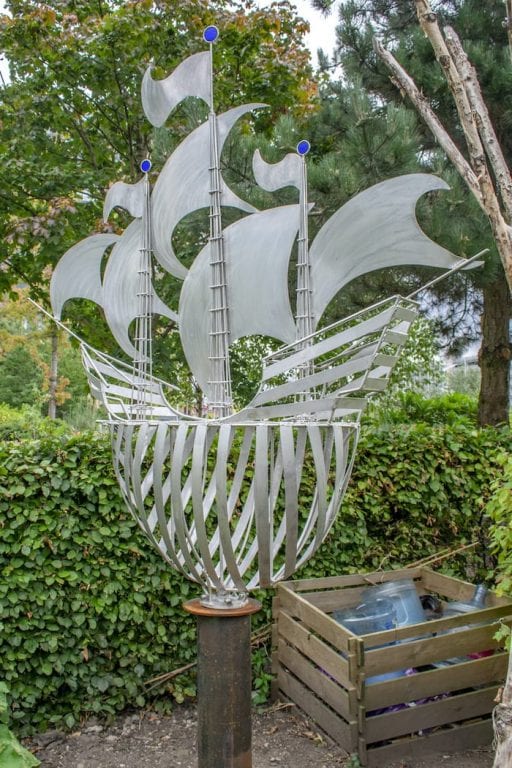
This sculpture made of steel, is a recreation of the Blue Peter Ship’s galleon. The artist Steve Blayock became well known for his steel sculptures of animals and plant life. He was eventually commissioned by the BBC to design the Blue Peter Ship logo, of course using his signature material. The finished ship was then moved to Salford Quays in Manchester, where it was installed in the new Blue Peter garden at Media City.
MediaCity, Salford
Victoria Wood statue

A statue of much-loved comedian and actress Victoria Wood created by Graham Ibbeson, who sculpted a famous memorial to Eric Morecambe. The life-sized bronze statue in Bury was a joint project of Bury Council and Wood’s estate and was funded in part by a Crowdfunding appeal by her brother Chris Foote Wood. It depicts her performing with a typical onstage pose and takes pride of place opposite Bury Library, from which Wood used to steal books because she was too shy to ask a librarian how to join.
Library Gardens, Bury
Face of Wigan sculpture
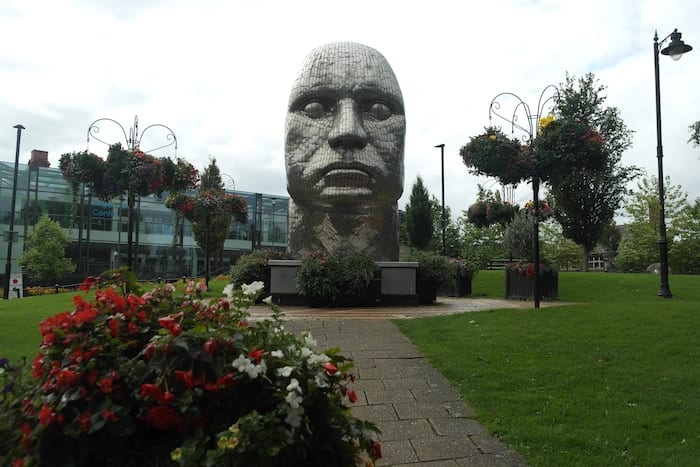
The Face of Wigan is a dramatic 5.5m high stainless steel sculpture of a face by acclaimed English sculptor Rick Kirby and is destined to become another iconic image of the Greater Manchester borough. Funding for the project totalling almost £80,000 was provided by Modus Properties, developers of Wigan’s Grand Arcade shopping centre as part of an agreement with Wigan Council to provide a major piece of public art in Wigan town centre.
Wigan town centre
A collection of over one hundred sculptures from public spaces around Greater Manchester are now available on Art UK’s website for a global audience, as part of their unique sculpture project.
Art UK is a cultural education charity on a mission to make the art in UK public collections accessible to everyone, for enjoyment, learning and research.
Did we miss something? Let us know: [email protected]
Want to be the first to receive all the latest news stories, what’s on and events from the heart of Manchester? Sign up here.
Manchester is a successful city, but there are many people that suffer. The I Love MCR Foundation helps raise vital funds to help improve the lives and prospects of people and communities across Greater Manchester – and we can’t do it without your help. So please donate or fundraise what you can because investing in your local community to help it thrive can be a massively rewarding experience. Thank you in advance!
Got a story worth sharing?
What’s the story? We are all ears when it comes to positive news and inspiring stories. You can send story ideas to [email protected]

Science and Industry Museum celebrates our brilliant bodies and incredible insides
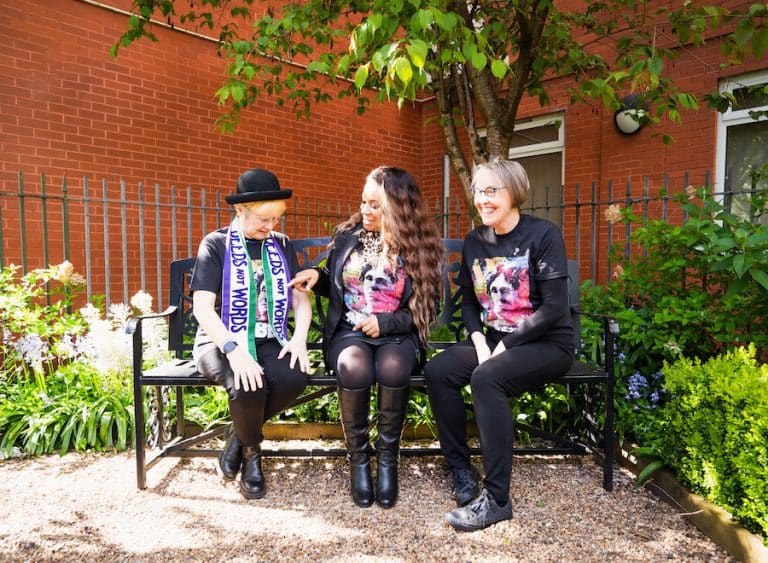
Manchester Women’s Aid marks 50 years with empowering fundraising appeal
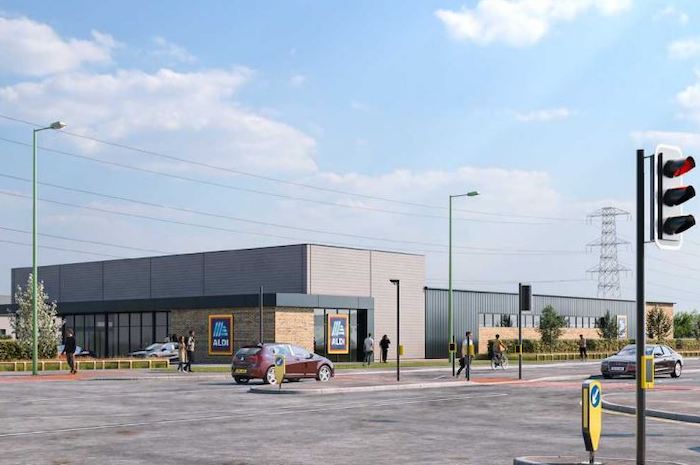
New Aldi and Costa drive-thru is coming to Tameside town

Worker Bee: Meet Katie Zelem, the captain of Manchester United

Worker Bee: Meet Maurizio Cecco, the founder of Salvi’s and Festa Italiana
